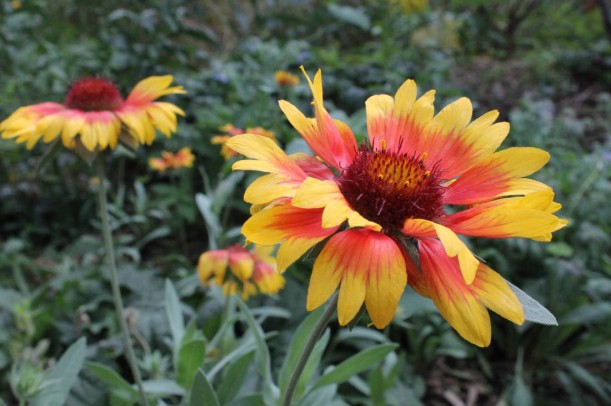The fall garden: it’s all about greens fading into blues and grays, then contrasting with bright oranges and yellows. Lush, soft textures contrast with dry, brown twigs and leaves. In short: it’s gorgeous. Why “clean it up”? Most of this stuff will stay in place until the spring in order to shelter overwintering insects for next year.
Here’s a photo tour of what’s happening outside my door, right now.

Okra plants are approximately six feet tall.

Meyer lemons—I’ve never had any get this big. For some reason the squirrels aren’t interested in them this year. I am trying to come up with a strategy to make the coming winter happier for this plant without breaking the bank.

Who needs mums, anyway? Fall asters are gorgeous AND beneficial.

Two thirds of this composition is serendipity. I only planted the purple dome aster; the calendula and brown-eyed susans reseeded from other areas of the garden.

My showy goldenrod has been covered in bumblebees—during a warm spell last week they were positively frantic.

Blanketflower—slowly reseeding and reblooming all summer long.

Who’s this little bug trying to hide in a calendula blossom?

Zig zag goldenrod, a favorite for shade. Great hosta alternative.

The spent blossoms of the big-leaved asters are taking on a puffball quality.

The prairie boulevard in autumn captures that quality I was trying to describe—contrasts of color and texture that are unique to this season.

Blue false indigo leaves, their black seed pods, and more brown eyed susans in the background.

Zinnias are a little obviously non-native at this point, but so pretty.

Magnolia leaves starting to give it up.

Fall is parsley’s time to shine. It’s very cold-hardy so I’ll keep picking it until it’s covered by snow.

I love the giant spiders of September. This one’s right outside our dining room window.

Bull’s Blood beets, grown for their incredibly nutritious and beautiful leaves. They’re also very cold-hardy so I don’t need to rush to get them picked and eaten.

In order of cold-hardiness: collards, chard and kale. Kale withstands light frosts easily so I’m prioritizing eating up the collards and chard right now. We’re not expecting frost for at least a couple more weeks—early- to mid-October has become the norm now for first frost in the Twin Cities.

A new-to-me vegetable for 2019: malabar spinach! I’ll definitely grow this again. It was so easy and (unlike so many other things) it thrived in the heat and humidity.

I have several Autumn Joy Sedums in my yard, one of the few non-natives that I keep. They used to get covered in bees in the fall, but this year very few bees are showing interest, due to the large numbers of goldenrod I now provide. Sedums provide nectar, but lack certain vitamins and minerals that bees need to survive the long winter. Goldenrod > Autumn Joy Sedum. That’s really the bottom line. If these die out, I won’t fuss. For now they’re occupying a space that’s otherwise been difficult to fill in right next to my A/C unit.

Anneke’s Japanese-style fairy garden had a rough summer, but still has some nice textures going on. I’ll have to bring this jade in for the winter.

Jalapeños are still going strong.

Comfrey. Plant comfrey only if you really truly intend to use it—it’s a great compost pile activator, and makes a potent compost tea. I can pull this entire plant out at the root two or three times each summer and it always comes roaring back. I will pull it out a final time in the coming weeks and use it for a winter mulch in the vegetable garden.
Fall is such a busy and stressful time of year, and it was a lovely break for me to spend my morning in the garden, taking these photos to share with you. Thanks for looking.

